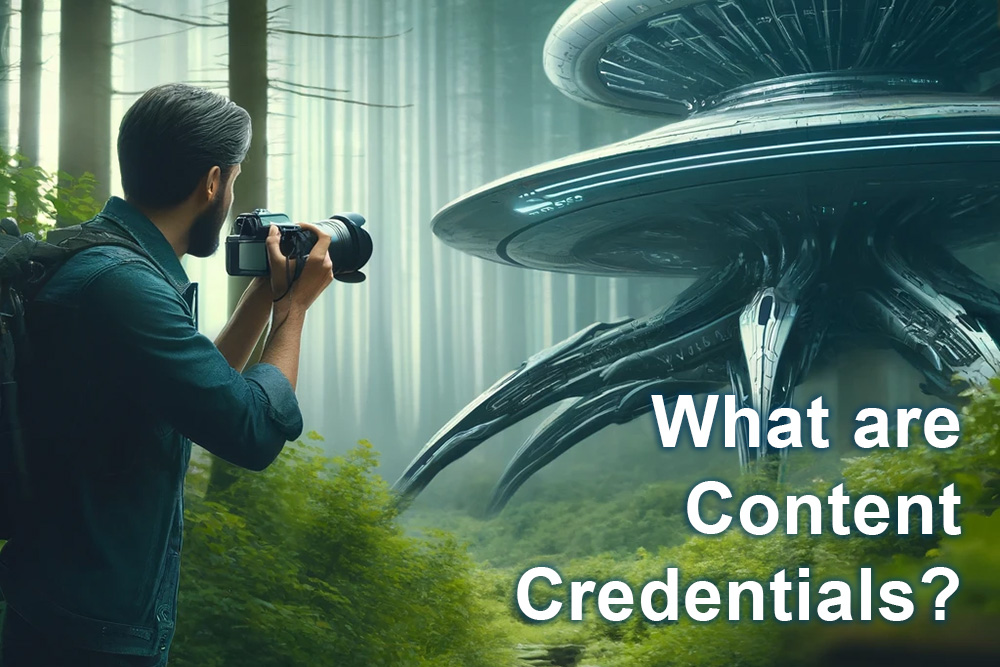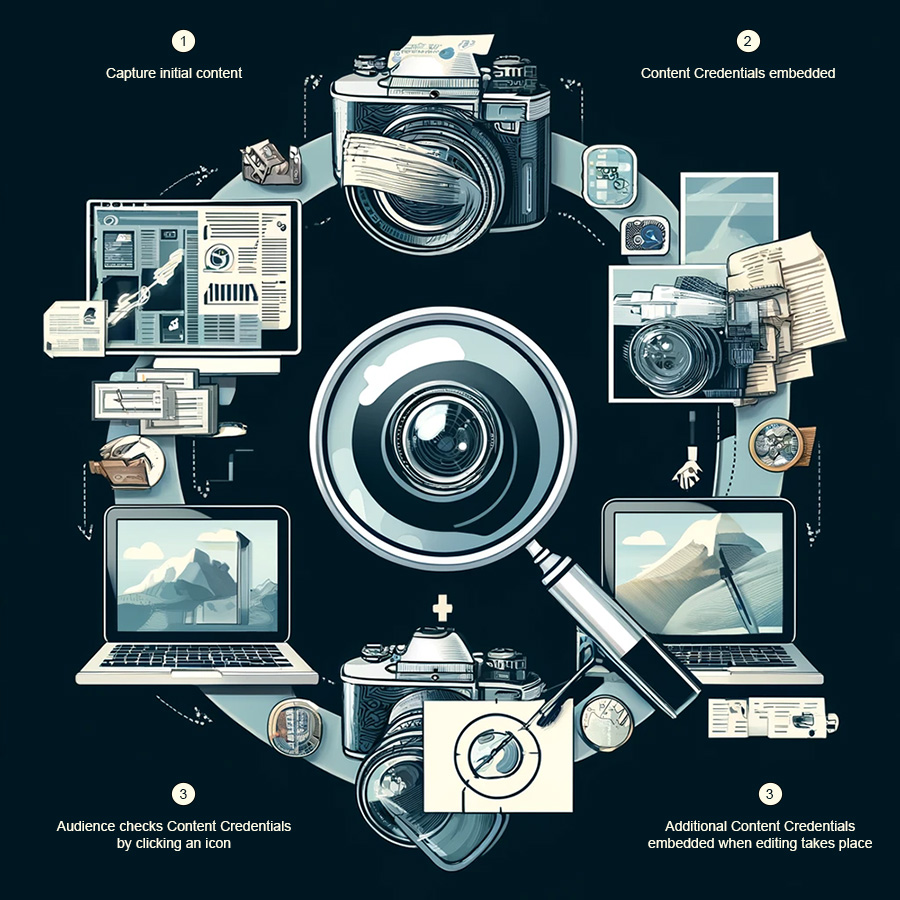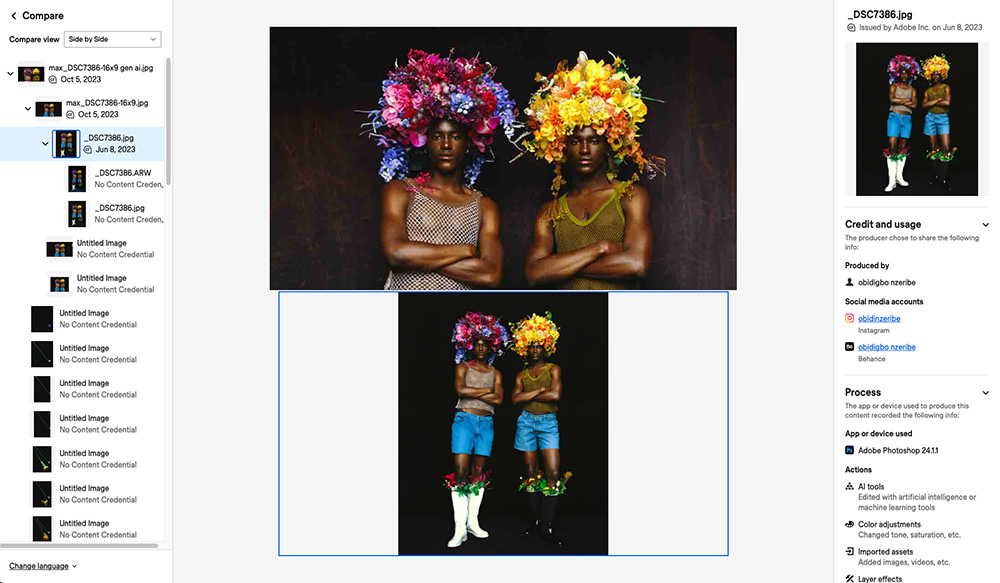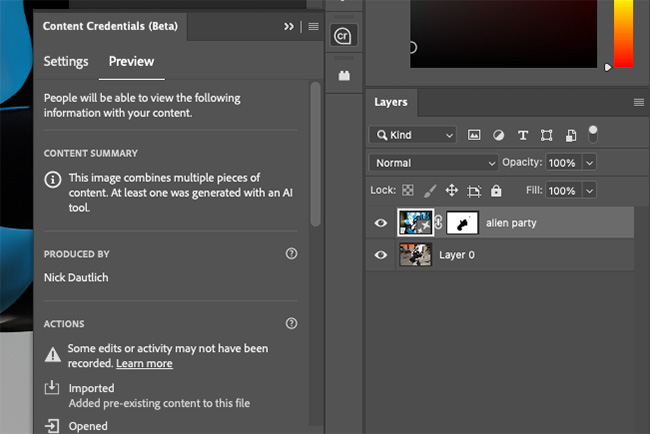- Call us: 01444 237070
- Contact Us
- Stores
- Sign In / Register
-
- Back
- Used Cameras
- Used Accessories
- Used Lenses
- Used Video
- Used Film Equipment
- Used Stock Alert
- Used Blank Test
- Sell or Part Exchange
- Used Clearance
- Recently Added Used Equipment
- Park Picks
- All Used Black Friday Deals
- Faulty
- Trade-In
- Blog
- New in
- Call us
- Contact us
- Stores
- Sign in
- Categories
- Tips & Inspiration
- Reviews
- News
- Events
- Features
- Buying Guides
- Competitions
What are Content Credentials
In a digital age where photography is ubiquitous, distinguishing between genuine and altered images has become a challenge. This blog post delves into content authenticity and what Content Credentials means for photography, its growing role for photographers, and strategies to safeguard your work against the increase of manipulated photos.
Whether you're a professional creator looking to integrate this technology into your work or just curious about what content credentials signify for the future, this photography feature has everything you need to know.

What does Content Credentials mean?
Content Credentials, also known as metadata, is data embedded into a piece of content. The data records crucial information such as camera settings, date and location of the capture, editing and copyright information. It was developed by a cross-company organisation, the Coalition for Content Provenance and Authenticity (C2PA).
The Coalition for Content Provenance and Authenticity includes some of the biggest names in content production and exposure, such as Adobe, Microsoft, Google, Twitter, Leica, Nikon and Truepic to name a few.
How does Content Credentials Work?
If you have a CAI compliant camera, it will record and embed data directly with every photograph. Using Cryptography, provenance information is bound to an image, storing initial creation information as well as any changes, by creating a tamper-evident record for inspection and validation.
This ensures that every single edit or manipulation can be checked, including when AI was used to make adjustments. If an image is missing any credentials information, this will be highlighted, ensuring the audience can take missing information as a sign that the image is manipulated in some way, which wasn’t recorded.

Which cameras support Content Credentials?
At the tail end of 2023 Leica pioneered with the world’s first Content Authentication Initiative (CAI) compliance in the M11-P Rangefinder Camera. Nikon implemented it on the Z9, and Sony followed suit, adding compliance to the A1, A7S III and A7 IV cameras through Sony Firmware Updates Released Spring 2024.
As AI and editing become more prevalent, we expect that the vast majority of digital cameras will support this feature in the not too distant future, whether through firmware updates or new releases.
The Importance of Content Credentials in Your Photos
For certain types of photography, creating and maintaining content authenticity is crucial when fostering audience trust. Authentic images reflect a photographer's vision, enhancing audience understanding by assuring of the genuineness of captured moments. For obviously manipulated digital art, content authenticity may not deemed essential, although there are many benefits for the creator.

Verify tool showing change history of a single image
Should you add Content Credentials to your work?
If nothing else, maintaining a digital trail credits the original creator of an image and ensures a clear record of its history and authenticity. This level of traceability is crucial for confirming an image's authenticity, and safeguarding the photographer's intellectual property rights, which was all but impossible previously.

The Content Credentials (Beta) dialogue
How to add Content Credentials in Adobe Photoshop?
In Adobe Photoshop, open the Content Credentials dialogue in order to engage Content Credentials. Checkboxes enable the addition of certain metadata, although any AI being utilised will recorded by default. When saving images you can choose via Adobe Photoshop settings whether to embed to images, or store data in the Cloud.
Storing metadata in the Cloud offers advantages, including smaller file sizes and the ability to restore data if it has been lost for any reason. For example, if someone screen captures your image and continues on to make changes, the ‘Search for possible matches’ function in Verify (discussed below), will find the original if it was stored in the cloud. That’s it, you’re now ready to publish your image and your audience can check Content Credentials for themselves.
Adding Content Credentials in Adobe Photoshop Video Via the Content Authenticity Initiative
How do you check Content Credentials?
When an image with Content Credentials appears on the internet it will allow the audience to check its metadata through an icon or ‘pin’, as well as via a service such as https://contentcredentials.org/verify. This verification ensures full transparency, highlighted by the examples here.
This tool allows anyone to detect fake elements in an image, which is vital for news organisations, politicians, celebrities and businesses, which want their audience to maintain full trust in their content output.

Does Content Credentials only work with photos?
Content Credentials is being implemented for stills, videos, audio files and other content types. Organisations like the BBC News has introduced content credentials, confirming where an image or video came from and how its authenticity has been verified, which is essential thanks to deep fakes, political misinformation and the growth of AI-generated content.
The Future of Content Authenticity in Photography and content creation
As we look toward the future of content authenticity in digital photography and content creation, emerging technologies hold the promise of transforming how authenticity is established, maintained, and verified. Blockchain technology, for example, is poised to play a pivotal role.
By creating immutable records of creation and ownership, blockchain can provide a decentralised and tamper-proof ledger for photographers. This means that from the moment an image is captured, its journey through edits, shares, and publications can be tracked with absolute certainty, providing an unprecedented level of authenticity and protection against unauthorised use.

Icon which shows credentials of image capture with Truepic
Artificial intelligence (AI) is another frontier set to redefine content authenticity. AI algorithms are becoming increasingly sophisticated at detecting manipulations in images, even those invisible to the human eye. AI can automate the embedding of digital watermarks and metadata, making it easier for creators to claim and maintain ownership of their work.
In a world where AI and machine learning evolve, we can expect a future where the authenticity of digital content is seamlessly integrated into the creation process, enabling photographers and creators to focus on innovation while safeguarding their intellectual property with minimal intrusion into the viewer’s enjoyment.
Although perhaps ironic that Adobe is central to these new technologies, for today, adopting Content Credentials into your workflow from the camera and Adobe Photoshop can future-proof your content and provide a means for viewers to check how your artwork came into being. By embracing these advancements and incorporating them into our practices, we empower ourselves to create with confidence, ensuring work remains genuine and protected.
Share this post:
By Nick Dautlich on 02/04/2024
Nick Dautlich
Senior Content Writer and Product Reviewer
Nick Dautlich is the Senior Content Writer and Product Reviewer at Park Cameras, with over 15 years of photography experience. A Sony Imaging Professional and expert reviewer, Nick has worked with major brands such as Canon, Sony and Nikon. His work is also featured on Vanguard World UK’s website, Capture Landscapes, and Shutter Evolve. Nick’s photography includes National Trust projects and magazine covers and he is passionate about landscapes and storytelling. Nick also enjoys hiking and teaching his children about nature. Learn more on his profile page.

Trade in your old equipment
Fast and easy trade in service ensures your old gear is collected efficiently and you are paid quickly! It's very simple to trade in your unwanted photography gear. Just head over to our dedicated Sell or Part Exchange page, fill out the details, and we'll get back to you with an offer for your old gear. Take the cash, or put it towards the cost of your new gear. It's up to you! Find out more
sign up to the newsletter
Keep up to date on the latest photography news, events and offers. Sign up now
